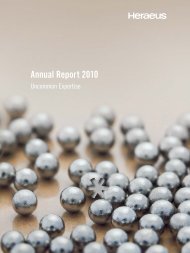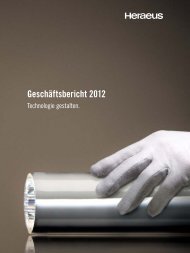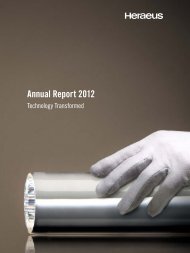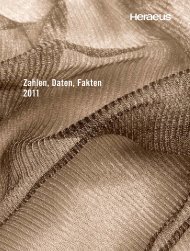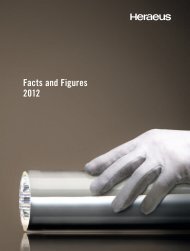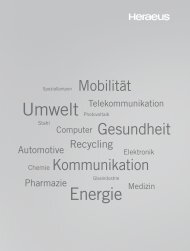English
English
English
You also want an ePaper? Increase the reach of your titles
YUMPU automatically turns print PDFs into web optimized ePapers that Google loves.
technology report 02<br />
INDUSTRY<br />
After a long day at the office, Thomas W. is driving home<br />
in his car. It’s already dark when he reaches a large, forested<br />
area. And that is when it happens: A deer leaps out<br />
into the road. Thomas W. slams on the brakes, but cannot<br />
avoid the collision. But he’s lucky: His airbag deploys<br />
in time and prevents him from getting injured. At that<br />
moment, Thomas W. certainly isn’t thinking that infrared<br />
heat helped save his life. But what role did infrared heat<br />
technology actually play in Thomas W.’s case?<br />
Airbag material is coated with silicone, making the surface<br />
slippery and ensuring that the airbag unfolds in a fraction<br />
of a second when it really counts. Carbon medium wave<br />
infrared emitters dry it quickly and safely – an innovative<br />
development from Heraeus Noblelight, the specialty lighting<br />
sources manufacturer.<br />
In our cars, we are surrounded<br />
by both structural<br />
and functioning parts that<br />
came into contact with<br />
infrared heat at least<br />
once during the production<br />
process. Mirrors,<br />
auto carpets, wiper fluid<br />
containers, rear window<br />
Airbag material is coated with shelves, auto glass, seat<br />
silicone.<br />
covers, trim, rubber seals,<br />
gas tanks, pumps, transmissions, oil pans, brake pads –<br />
infrared heat is used everywhere to shape, dry, join or trim<br />
components.<br />
Infrared makes production processes more cost effective<br />
The triumph of infrared technology in the automobile<br />
industry can be attributed to a number of reasons. Infrared<br />
technology is flexible and diverse, and can produce a<br />
suitable heating process for almost every material. Cost<br />
effectiveness is another strong suit: For automotive manufacturers<br />
in particular, every last dollar counts. Infrared<br />
emitters can heat a specifically targeted area, which<br />
increases process speeds, thereby making it possible to<br />
produce more in the same period of time. “Another advantage<br />
of infrared heat is that it can be switched on and off<br />
quickly, only heating the material to be treated and not<br />
the area around it. With today’s high energy costs, that’s<br />
an aspect that shouldn’t be underestimated,” states Ian<br />
Bartley, Head of Sales at Heraeus Noblelight in Great<br />
Britain.<br />
Advantages that also benefit owners of luxury cars. When<br />
the driver of a new Bentley Continental GT convertible is<br />
enjoying the sun with the top down, infrared emitters from<br />
Heraeus ensure that the cloth canopy remains uncreased<br />
5






